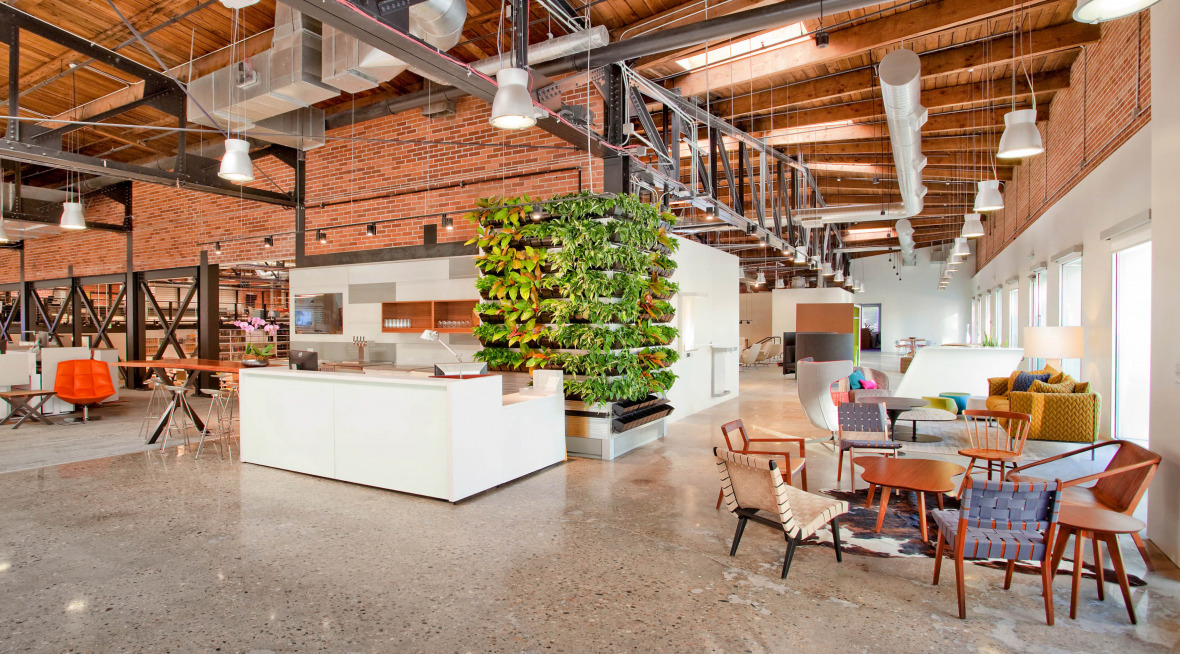We use cookies to maximize your online experience with us. By closing this window, you consent to our cookie policy. You can change your cookie settings in your browser any time. For more information, please see our Privacy Policy located on the footer of this site.
Biophilic Design is Good for Business

Whether or not you consider yourself a fan of the great outdoors, scientific research shows that nature is good for us. However, due to busy lifestyles and long hours at work, the Environmental Protection Agency calculated that Americans spend about 87% of their time indoors, plus six percent in vehicles. Believing this lack of exposure to nature may contribute significantly to feelings of isolation, tension, and lethargy, advocates for biophilic design are urging organizations to integrate nature into their spaces to enhance wellbeing and creativity.
What is Biophilia
Biophilia, which translates to “love of life,” is a concept first popularized by Edward O. Wilson in 1984. He believed that there exists an innate relationship between humans and nature which drives a basic human need to continuously be connected to a natural environment. Biophilic design blends nature or nature-like elements into spaces in which we live and work to enhance our connection with nature.
How Does Biophilic Design Benefit Organizations?
Increasing rates of urbanization and technological proliferation are moving us further away from the natural elements that help to reduce stress and aid in recuperation. There have been a number of compelling studies over the last 35 years that demonstrate how implementing biophilic design positively impacts the following aspects:
Wellbeing
Environmental psychology research tells us that being connected to nature is an adaptive human function that allows for, and supports, psychological restoration. Visible connections to nature can have a positive effect on an individual’s stress levels, and the perception of wellbeing can increase by up to 15% when people work in surroundings that incorporate natural elements. Because wellbeing directly impacts an individual’s performance, a healthy wellbeing can boost satisfaction, creativity, teamwork, productivity, employee retention, and even a company’s bottom-line.
Concentration
The attention restoration theory suggests that because nature is effortlessly fascinating, it captures our attention without us having to consciously focus on it. This provides an opportunity to replenish our stores of attention control. Better yet, we don’t need to spend a large amount of time observing nature to reap the benefits. Engaging in nature-focused microbreaks, such as looking at nature through a window, taking a walk outside, or viewing a scenic screen saver, can improve attention in the workplace.
Creativity
There have been numerous studies performed that indicate nature can stimulate creativity. Memory, which helps you draw on past experiences and thoughts to form creative solutions, is improved after exposure to nature. Often inspiring, nature also increases brain function and helps relieve the sense of tight deadlines. Without the stress associated with a creative block, creativity can flourish.
Productivity
An individual’s wellbeing, concentration, and creativity is each directly proportional to productivity. When one aspect goes up, so does productivity. Imagine if all three go up! Through the correct implementation of biophilic design, organizations can positively affect all three at once and truly improve an employee’s productivity. One UK study even determined that exposing employees to plants throughout the office increased productivity by as much as 15%!
Incorporating Biophilia
It’s not difficult to introduce biophilic design into your space. Even on a limited budget, small changes can have a dramatic effect. We looked at four ways organizations can incorporate biophilic design into their spaces.
Outdoor Workspaces
Organizations are increasingly blurring the boundaries between indoors and outdoors. Whether alone or in a group, outdoor patios or seating areas provide employees a place to go to recharge, feel revitalized, or find inspiration.
Textures, Finishes, and Colors
When you can’t expand your space outside, bring nature inside. Nature-inspired patterns on walls, artwork, or textiles have been shown to increase engagement and relieve mental fatigue. Incorporating wood or stone finishes in flooring, wallcovering, or special architectural features also provide a stylish opportunity to introduce elements of biophilia.
Access to Windows and Natural Light
Removing walls that restrict sunlight to small areas of a floorplan can significantly impact your space for the better. The brighter floorplan will not only give the illusion of being larger, it will improve the mood and wellbeing of employees who now have increased access to natural light. If you’re worried the space is too open, try implementing glass modular walls. They will help create a separation of space while allowing natural light to pass through.
Plants and Living Systems
Adding plants throughout an environment is one of the simplest ways to exercise biophilia. Offering a natural and more welcoming feel for both employees and guests, plants improve the air quality through reduction in dust, mold, and CO2 levels. Due to the vast variety in sizes and types of plants and planters, potted plants can be placed almost anywhere within a space.
Living systems are another option becoming more mainstream. Basically a wall of plants, these systems can be scaled to fit available wall space and are easily removed for servicing or replacing. Some living systems can even help projects earn LEED credits.
A True Win-Win Scenario
The benefits of biophilia seem clear – a little bit goes a long way to improve mood and productivity.
As trends continue to favor urbanization, organizations need to take action to balance a less-than-ideal workspace and appeal to top talent. The adoption of any amount of biophilic design creates an extraordinary opportunity for organizations to improve employee wellbeing and productivity, resulting in a stronger overall competitive advantage.
